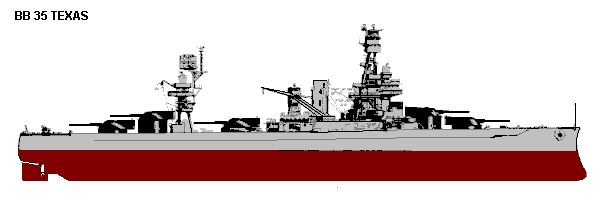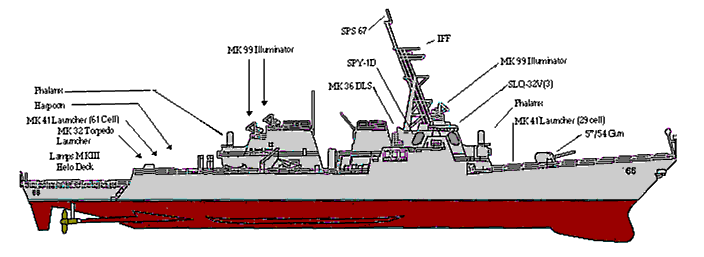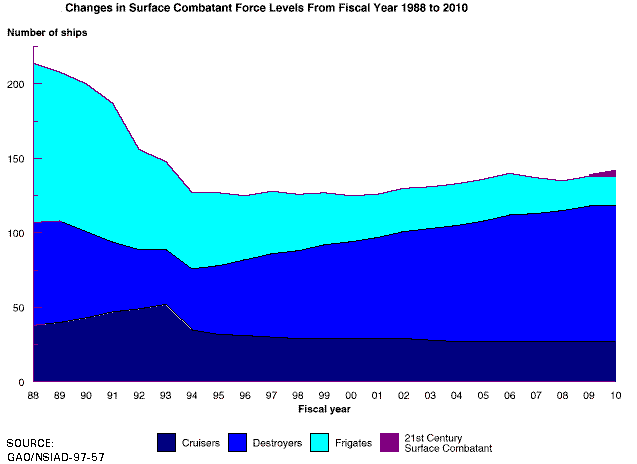





 Surface combatants -— cruisers, destroyers, and frigates -— provide the Navy
with a wide range of capabilities and choices to satisfy U.S. national
security objectives. In peacetime, these large, heavily armed multimission
ships carry out a wide range of day-to-day overseas presence missions and
enhance U.S. crisis response capabilities. During a conflict, surface
combatants would conduct combat operations against enemy submarines,
surface ships, aircraft, missiles, and targets ashore either independently or
with other military forces. Over the last decade, technological advances,
such as the Aegis combat system, the vertical launching system (VLS), and
the capability to launch Tomahawk cruise missiles, have significantly
expanded the range of tasks that the newer, more capable ships entering
the force can undertake.
The Navy believes that surface combatants and other forward deployed
forces will be important early in a conflict. Surface combatants can
provide protection of sea and air routes, ports, coastal airfields, and
facilities and substantial command, control, and communications
capabilities. The Navy also believes that surface combatant forces will
provide initial capabilities until additional forces arrive in the area.
Forward-deployed surface combatants could be available to immediately
strike targets on land with Tomahawk cruise missiles and provide naval
fire support for ground forces.
In the future surface combatant forces are also expected to
provide defense against ballistic missiles. A 1995 Navy surface combatant
study concluded that defense against theater ballistic missile and
Tomahawk strikes will be a high-priority task of Aegis-capable ships early
in an MRC.
Surface combatants -— cruisers, destroyers, and frigates -— provide the Navy
with a wide range of capabilities and choices to satisfy U.S. national
security objectives. In peacetime, these large, heavily armed multimission
ships carry out a wide range of day-to-day overseas presence missions and
enhance U.S. crisis response capabilities. During a conflict, surface
combatants would conduct combat operations against enemy submarines,
surface ships, aircraft, missiles, and targets ashore either independently or
with other military forces. Over the last decade, technological advances,
such as the Aegis combat system, the vertical launching system (VLS), and
the capability to launch Tomahawk cruise missiles, have significantly
expanded the range of tasks that the newer, more capable ships entering
the force can undertake.
The Navy believes that surface combatants and other forward deployed
forces will be important early in a conflict. Surface combatants can
provide protection of sea and air routes, ports, coastal airfields, and
facilities and substantial command, control, and communications
capabilities. The Navy also believes that surface combatant forces will
provide initial capabilities until additional forces arrive in the area.
Forward-deployed surface combatants could be available to immediately
strike targets on land with Tomahawk cruise missiles and provide naval
fire support for ground forces.
In the future surface combatant forces are also expected to
provide defense against ballistic missiles. A 1995 Navy surface combatant
study concluded that defense against theater ballistic missile and
Tomahawk strikes will be a high-priority task of Aegis-capable ships early
in an MRC.
Currently, the majority of surface combatants deploy as part of carrier battle groups for routine 6-month deployments to the Mediterranean Sea, western Pacific Ocean, and North Arabian Sea. As a major element of a carrier battle group, surface combatants provide the primary defensive capabilities for the group and contribute significant strike and fire support for joint operations ashore. Navy officials stated that one or more surface combatants are necessary at all times to escort and protect the aircraft carrier. Without them, an aircraft carrier could not safely deploy. Although the Navy has emphasized using its surface combatants more independently, they are still inherently linked to carrier force structure and deployments.
The Navy’s notional carrier battle group has six surface combatants, an aircraft carrier and its airwing, two nuclear attack submarines, and a fast combat support (logistics) ship. This notional configuration is considered to have the necessary capabilities to provide an initial crisis response from a forward posture. However, the actual number and type of ships assembled for each deployment will depend on the available assets, surface combatants already in area, and the needs of the joint unified commands.Surface combatants can also be deployed without a carrier either independently or as part of a surface action group. A surface action group generally consists of two or more surface combatants and deploys for unique operations, such as augmenting military coverage in world regions, providing humanitarian assistance, and conducting exercises with allied forces.
The only recent example of surface combatants being used for war-fighting roles in an Major Regional Contingency is the 1991 Persian Gulf War. Surface combatants were used to conduct several sea control and power projection missions, which included protecting maritime traffic, performing maritime intercept operations of contraband shipping to sever Iraqi trade, conducting deep-strike Tomahawk missile attacks against Iraq, and providing combat search and rescue operations in the region.The specific circumstances of the two envisioned MRCs would significantly affect the number of ships the Navy might use. According to current strategy documents, the Navy envisions a greater emphasis on fighting in littoral areas in the future. The Navy has not said how this shift in strategy to fighting in littoral areas would affect the size of its surface combatant fleet. Crisis and contingency missions for surface combatants include maritime intercept operations to enforce sanctions, humanitarian relief, air surveillance and air control, protection of U.S. forces, and strike operations.


The post-Cold War Bottom-Up Review concluded that a Navy comprised of 346 battle force ships 4 would be sufficient to carry out the U.S. military strategy by fiscal year 1999. It did not, however, specify a force goal for surface combatants. In congressional presentations subsequent to the review, DOD and the Navy indicated that 120 to 126 surface combatants would be needed to meet national security objectives. However, this force was determined largely from budget-driven priorities.
DOD’s Future Years Defense Program supports a force of at least 125 surface combatants that, according to DOD officials, is largely based on budget, industrial base, and operational considerations. DOD has not established a long-term surface combatant goal based on the number of ships it needs to implement the national security strategy. DOD has not clearly explained the process used to determine the number of surface combatants needed to fulfill the two nearly simultaneous major regional conflict (MRC) scenario specified in DOD guidance or the number needed to meet desired levels of peacetime presence, as it has done with aircraft carriers. It is unclear what key assumptions support the force size, such as expected allied contributions to war-fighting objectives.The Navy’s Surface Warfare Division’s August 1995 Surface Combatant Force Level Study concluded that 165 cruisers, destroyers, and frigates would be needed through 2010 to meet war-fighting requirements of two nearly simultaneous MRCs. According to the study, however, this number could be reduced to 145 ships, including 10 reserve frigates, with use of allied surface combatants. The subsequent 21st Century Surface Combatant Force Architecture Assessment, completed in February 1996 by the Naval Surface Warfare Center, suggested that the surface combatant force level from 2010 to 2030 could be even smaller than the 145-ship force recommended by the earlier study.
Tethered Presence refers to the practice of maintaining ships at acceptable distances away from a specific area of presence operations while allowing them to return within a specified number of days. The tethered presence policy is a Chairman, Joint Chiefs of Staff, and DOD policy that is supported by funding in the fiscal year 1998 budget and the Future Years Defense Program for fiscal years 1998 through 2003. This policy results in lower force level requirements than those needed to support continuous presence in all three major regions. DOD analyses for the Quadrennial Defense Review show that tethered presence requires about 110 surface combatants, including 16 ships assigned to the Western Hemisphere group and 10 with similar missions on the West Coast of the United States, to support operations, such as counternarcotics, in other areas. DOD considers this force to be adequate to meet the apportionment of forces required by the commanders in chief for the current two nearly simultaneous MRC strategy.The Navy has studied the effect on force size of changing the two nearly simultaneous MRC requirement. With the assumption that a 145-ship force of current ship types, with some allied support, is needed for the current MRC requirement, the assessment calculated that changing the requirement to two simultaneous MRCs could increase the required force size by about 20 ships. Changing the requirement to two sequential MRCs or one MRC could reduce the war-fighting force requirement by as much as 45 ships (assuming some allied support), to only 100 ships.
Although the size of the force has declined, surface combatants represent more than one-third of the Navy’s battle force ships, and the proportion and number of ships in the force with the Aegis combat system have been increasing. To reduce its Cold War force, the Navy retired many of its older, less capable surface combatants before the end of their planned service lives. Frigates were reduced more than other surface combatants because of the diminished threat to naval carrier battle groups and merchant shipping in the open ocean.

Technological innovations could also affect the requirement for surface combatants. These improvements could provide greater efficiencies in the use of the force and allow changes in doctrine and operational concepts that could reduce force requirements. These include improvements to the Tomahawk cruise missile, which could allow the missile to be used for tactical applications in support of ground operations; modifications to the Aegis combat system and Standard missile, which could provide a defense against theater ballistic missile attacks while operating in littoral areas; and introduction of the Cooperative Engagement Capability on existing and new combatants, other ships, and airborne elements, which will enhance ship self-defense capabilities by increasing response time and the amount of information available to defend against antiship cruise missile threats. It is also possible that the introduction of the Arsenal Ship, which would carry a large inventory of missiles and potentially serve several military purposes, could permit the Navy and the other services to retire or forego purchases of some assets, such as aircraft carriers, surface combatants, ground-based launchers, or combat aircraft.
Potential changes in operational practices could increase the availability of ships for deployment in peacetime. These changes include consideration of additional overseas home ports and changes to deployment schemes and personnel policies, such as shortening the time between deployments. Lengthening the deployment period, rotating crews, increasing transit speeds, and using different maintenance schemes are other potential options to increase the availability of ships for deployment in peacetime. These options may offer opportunities for the Navy to achieve national security objectives more efficiently as it operates with a smaller force structure and possibly smaller budgets. The Navy’s ability to achieve and sustain a desired force size is affected by the service lives of existing ships. Navy cruisers and destroyers have historically been retired by 30 years of service and frigates by 22 years of service. In recent force planning for ships, the Navy uses notional estimated service lives of 35 years for Aegis-capable cruisers and all current classes of destroyers and 24- to 32-year service lives for most Oliver Hazard Perry-class frigates retiring after fiscal year 1999.